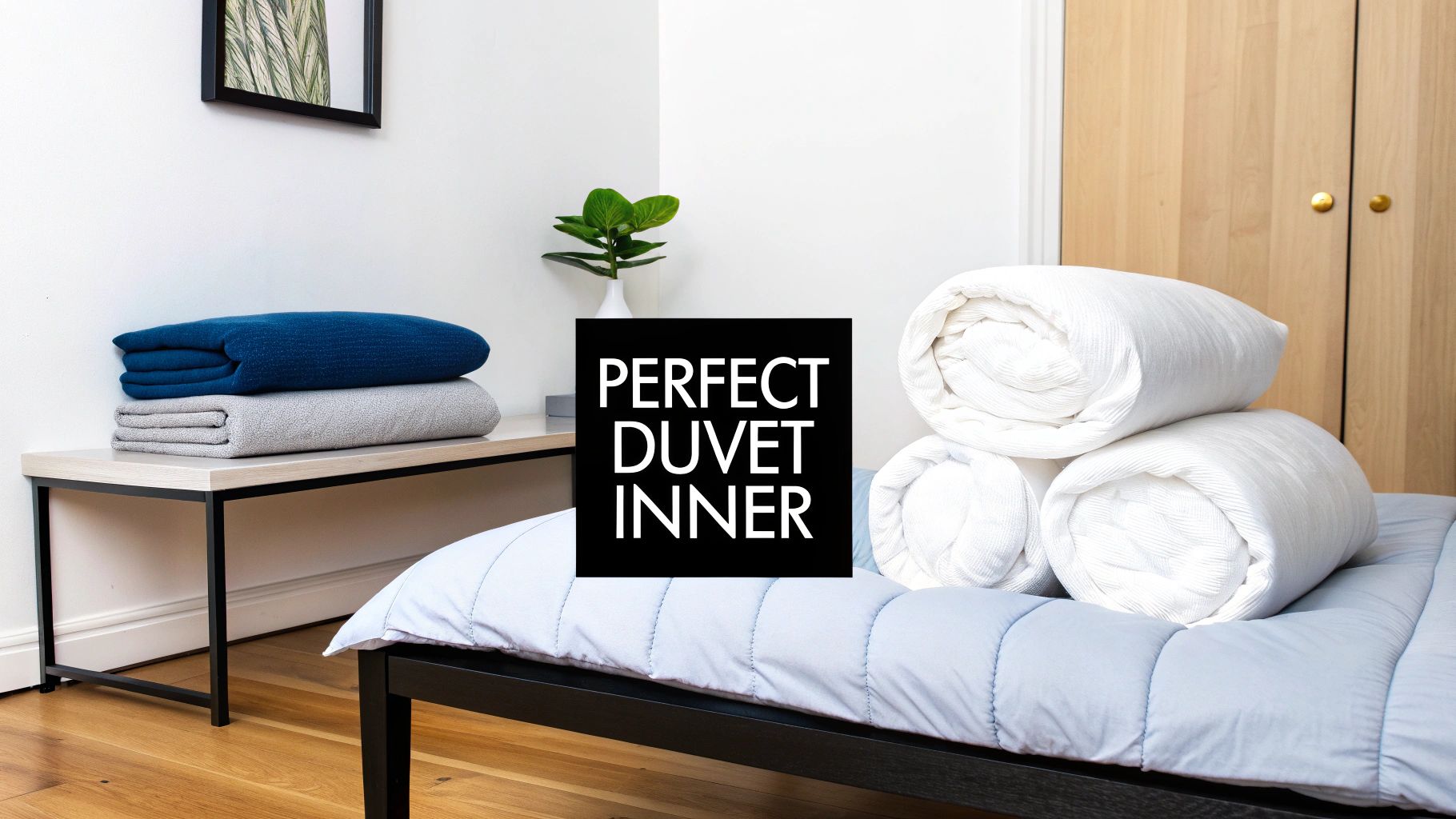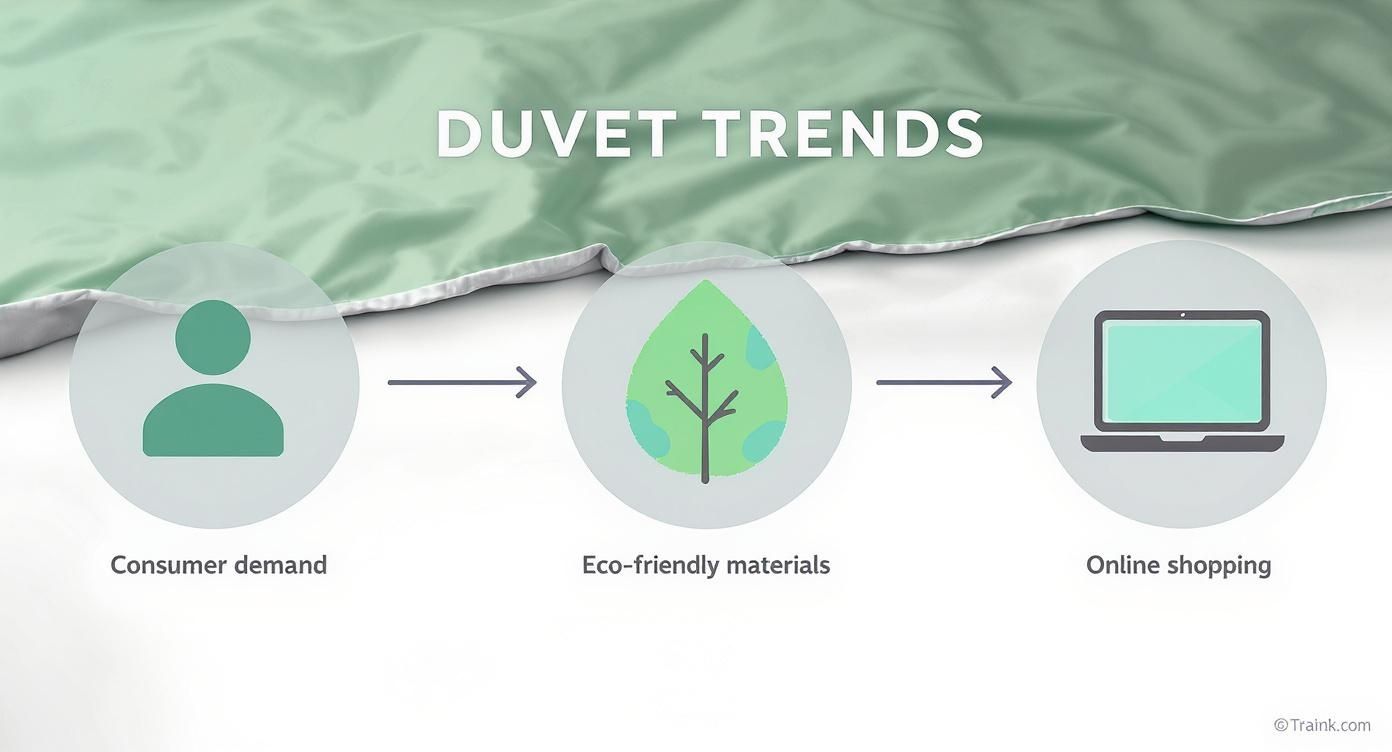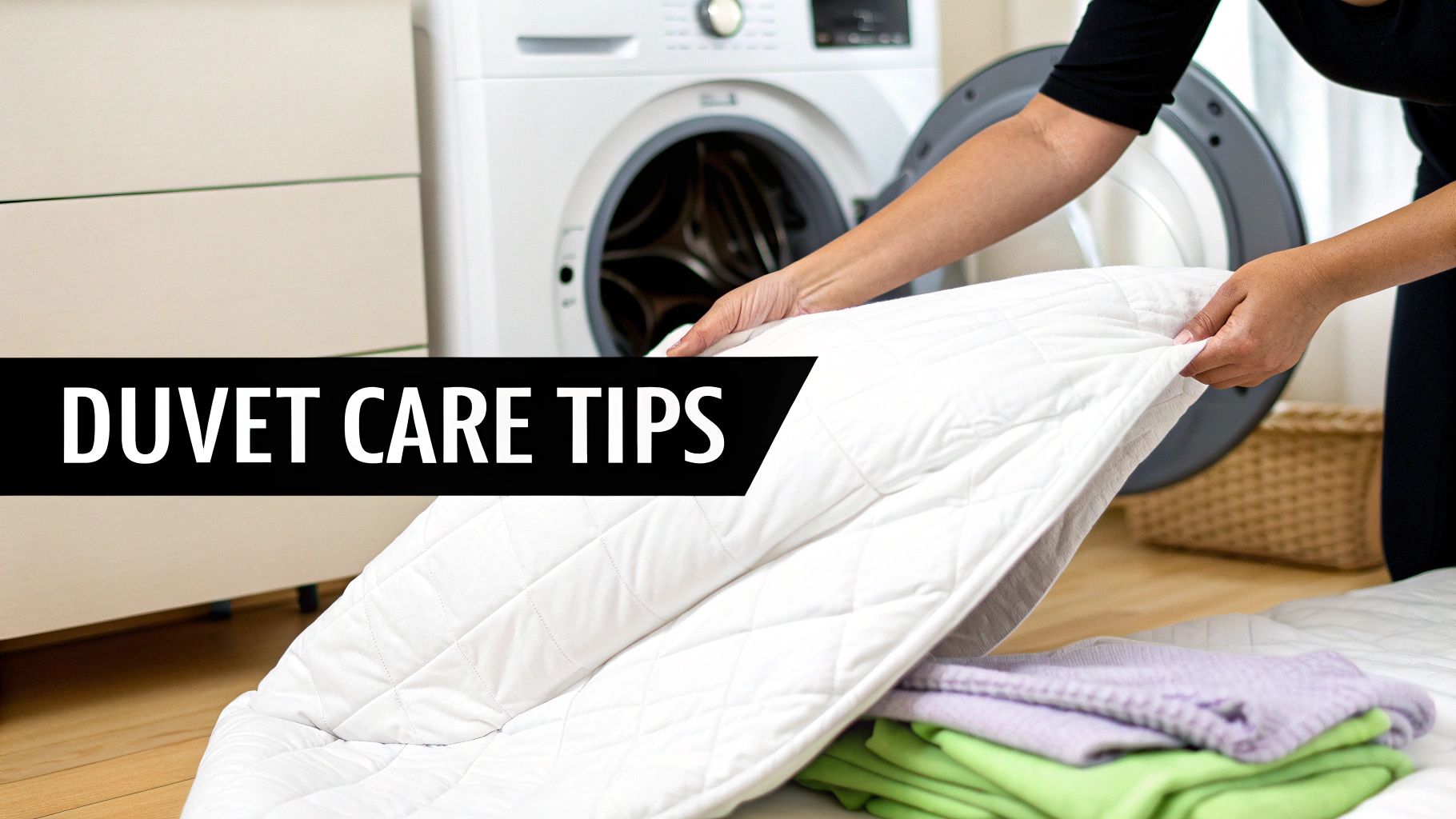Finding the right duvet inner is one of the quickest ways to completely transform your sleep. Here in New Zealand, we know a thing or two about changing seasons, and having a quality duvet that balances warmth, breathability, and even sustainability can make all the difference. Get the fill and the warmth rating right, and you'll be waking up feeling properly refreshed.
Choosing the Right Duvet Inner for a Better Sleep

The first thing to consider is what's actually inside your duvet. The filling is what dictates how it holds warmth, how it breathes, and how it feels draped over you.
- Wool: A brilliant natural choice, wool is fantastic at regulating temperature and wicking away moisture. It keeps you warm in winter and surprisingly cool in summer.
- Down: If you're after that cloud-like, lofty softness, nothing beats down. It offers incredible warmth for its weight.
- Synthetic fibres: These are a great option if you're on a budget or need something that's super easy to care for and hypoallergenic.
Next up is the 'tog' rating, which is simply a measure of how warm the duvet is. Matching the tog to your home and the season means you'll stay cosy without ever overheating.
- A 10.5 tog is often perfect for summer nights or if you live in a well-heated modern home.
- A 13.5 tog is a solid all-rounder that suits most Kiwi homes throughout the year.
- An 18 tog is what you'll want for those extra-chilly nights, especially down in the South Island.
Size and Fit Guide
It might seem obvious, but getting the size right is crucial. A duvet that's too small lets in drafts, while one that's too big can be cumbersome. Your duvet inner should always match your bed size.
- Single: A 140 x 200 cm duvet gives a nice, snug fit.
- Double: The 180 x 200 cm size provides a balanced spread.
- Super King: For luxurious, full coverage, you'll need a 265 x 240 cm duvet.
A properly fitted duvet inner can increase sleep quality by up to 20%. It’s a small detail that makes a huge impact.
If allergies are a concern, look for hypoallergenic fills to keep dust mites and other triggers at bay. Materials like Tencel or silk are naturally resistant to common allergens, and certified organic wool is great at resisting moisture and mould growth.
Benefits of Local Craftsmanship
There's a real advantage to choosing New Zealand-made duvet inners. Not only are you supporting local artisans, but you often get a much higher standard of quality control.
- Shorter supply chains mean a smaller carbon footprint.
- Many local workshops can even offer custom tog ratings if you need something specific.
- Buying direct from the maker helps strengthen our community businesses.
Once you understand these key factors, you're well on your way to picking a duvet inner that perfectly suits your sleeping style, your home, and your values.
Why not visit The Foxes Den online to explore a range of premium duvet inners, all crafted with Kiwi homes and our unique climate in mind.
By choosing well and looking after it properly, you'll be set for deeper, more comfortable rest every single night.
Sweet dreams start tonight.
How Bedding Trends Shape Your Choices
Have you ever wondered why one minute everyone's talking about wool duvets, and the next, it's all about Tencel? What you see on the shelves here in New Zealand isn’t just a random collection of bedding. It’s a direct reflection of how we’re all thinking about our homes, our health, and our planet.
Keeping an eye on these trends helps you cut through the marketing noise and find a duvet that’s genuinely right for you. It’s about understanding the ‘why’ behind the products on offer.
One of the biggest shifts we’re seeing is a huge swing towards natural and sustainable materials. Kiwis are more curious than ever about where their products come from and what’s actually inside them. This has put a spotlight on fillings like locally sourced wool, ethically certified down, and innovative plant-based fibres. These aren't just fads; they deliver real-world benefits like incredible breathability and a much lighter touch on the environment.
The Rise of Conscious Consumerism
This growing eco-awareness has a ripple effect. Brands are now expected to be far more open about how their products are made, from the farm to your bedroom. Shoppers are actively looking for certifications that guarantee things like animal welfare and sustainable sourcing.
The good news? It’s now easier than ever to find high-quality, ethically produced duvet inners nz. This isn't just a niche concern anymore; it’s a powerful movement pushing the whole industry to do better.
Comfort alone just doesn’t cut it for many people these days. This is happening on a global scale, too. The worldwide duvet market is expected to jump from US$1.93 billion to US$2.64 billion by 2032, largely because people are demanding better quality and more sustainable options. While New Zealand is a small piece of that pie, our passion for premium, eco-friendly bedding is a strong and growing influence. You can explore more about these global market dynamics to see the bigger picture.
How Online Shopping Expands Your Options
The other game-changer has been online shopping. You're no longer stuck with the limited selection at your local department store. Now, you’ve got access to a massive range of specialised products from small-scale artisans and niche retailers all over the country.
Being able to compare different materials, dive into genuine customer reviews, and buy directly from the people who make the products is incredibly empowering. It puts you in the driver's seat, letting you find a duvet that lines up perfectly with how you sleep and what you value.
This digital marketplace opens up a world of possibilities that you just wouldn't find in a traditional shop. For instance, you can now discover:
- Customisable Tog Ratings: Some online makers will create a duvet with the exact warmth level you need.
- Specialised Blends: You might come across unique combinations, like wool blended with silk, designed for a very specific type of comfort.
- Direct-from-Workshop Pricing: Buying straight from the source often means getting a much better deal on a beautifully handcrafted product.
By understanding these two major forces—the move towards sustainability and the incredible choice offered online—you become a much smarter shopper. You can easily tell the difference between a fleeting trend and a true innovation, helping you invest in a duvet inner that will give you a fantastic night's sleep for many years.
Comparing Materials and Understanding Tog Ratings
Choosing the right material for your duvet inner is a bit like picking the perfect coat. You wouldn't wear a light jacket in a southerly buster, and you wouldn't wear a heavy parka on a warm summer evening. Each fill offers a different kind of warmth and feel, and getting your head around the options is the key to a comfortable night's sleep, year-round.
The material tucked inside your duvet inner is what does all the work, from how it traps heat to how well it lets your skin breathe. What we're seeing in New Zealand right now is a real shift in what people are looking for.

This snapshot shows us that Kiwis are increasingly focused on eco-friendly materials, and the ease of online shopping is playing a huge role. It’s a perfect storm of consumer demand and local values pushing the market toward more sustainable and accessible bedding.
Breaking Down the Fills
So, what are your main options? Let's get into the most common materials you'll find, as each one has its own personality and suits different sleepers and homes.
- Wool: Think of wool as nature’s original smart textile. It’s absolutely brilliant at regulating temperature, keeping you snug in winter but also wicking moisture away to help you stay cool in summer.
- Down: If you dream of sleeping under a fluffy, lightweight cloud, nothing beats down. It gives you incredible warmth for its weight and creates that classic, lofty, puffy look we all love.
- Synthetic (Microfibre/Polyester): A super practical choice, synthetic fills are often hypoallergenic and incredibly easy to look after. They provide reliable, even warmth and are a fantastic option for anyone with allergies or for the kids' beds.
- Tencel/Lyocell: Made from sustainably sourced wood pulp, Tencel is famous for its silky-smooth feel and amazing moisture-wicking ability, which makes it a godsend for hot sleepers.
In New Zealand, there's a definite lean towards natural fibres like wool and down. This preference aligns perfectly with our generally eco-conscious and health-aware mindset. It's a trend that reflects how Kiwi values are shaping our shopping habits, even as we browse options from all over the world online.
What On Earth Is a Tog Rating?
Once you have an idea of the material you want, the next piece of the puzzle is figuring out how warm it will be. This is where the tog rating steps in.
At its core, a tog rating is simply a standardised measure of how well a duvet insulates. The higher the tog number, the toastier the duvet will be. It’s a wonderfully straightforward system for matching your bedding to the season and your own personal comfort zone.
For example, a low tog rating of around 3.0 - 4.5 is ideal for summer, while a high tog of 13.5 or more is what you’ll want for the depths of a chilly winter. A good all-rounder, or "all-season" duvet, usually lands around the 10.5 mark.
Here’s a handy table to see how it all fits together.
Duvet Inner Material and Tog Comparison
This table breaks down the common materials, their typical warmth ratings, and where they really shine, helping you match a fill to your needs.
| Material | Tog Range (gsm) | Best For | Key Benefits |
|---|---|---|---|
| Wool | 400-600 gsm | Year-round comfort, temperature regulation | Naturally breathable, moisture-wicking, hypoallergenic |
| Down | 4.5 - 15.0 tog | Lightweight luxury, cold winters | Unbeatable warmth-to-weight ratio, lofty feel |
| Synthetic | 4.5 - 13.5 tog | Allergy sufferers, kids, easy care | Hypoallergenic, durable, machine washable, budget-friendly |
| Tencel | 200-400 gsm | Hot sleepers, humid climates | Exceptionally soft, sustainable, superior moisture management |
Choosing the perfect duvet isn't just about the material or the tog rating alone; it's about how they work together.
It's crucial to remember that the fill and the tog rating are a team. A 10.5 tog down duvet will feel much lighter and airier than a 10.5 tog wool one, even though they technically provide the same amount of insulation. This is why you need to consider both to find your perfect match. For those with bigger beds, these factors are just as important, which is something we cover in our guide to selecting the right Super King duvet.
How to Select the Perfect Size and Warmth
Choosing the right size and warmth for your duvet inner is where the magic really happens. Get it right, and you've got the secret to a perfectly inviting bed. Get it wrong, and you're either fighting for the covers all night or kicking them off in a sweat.
The first, most crucial step is matching the duvet to your mattress size. While New Zealand has standard bed dimensions, you want to ensure your inner gives you generous coverage on all sides. That little bit of extra drape not only looks far more luxurious but also keeps chilly drafts at bay.
Matching Your Duvet to Your Bed
The goal is a perfect fit – a duvet that hangs beautifully over the edges of your bed without dragging on the floor. While an oversized, plush look is wonderfully cosy, a properly fitted inner provides even warmth and makes changing the duvet cover much less of a chore.
Here’s a quick rundown of the standard pairings we use here in NZ:
- Single Bed: A 140cm x 210cm inner is your best bet.
- King Single Bed: Look for a 180cm x 210cm inner for a great fit.
- Queen Bed: The standard 210cm x 210cm inner gives you excellent coverage.
- King Bed: A 245cm x 210cm inner fits like a dream.
- Super King Bed: For the ultimate in spacious comfort, go for a 265cm x 210cm inner.
Getting these dimensions spot-on is key. If you want to dive deeper, you can explore our complete guide to New Zealand duvet sizes to make sure you've got it just right.
As you can see, the right size is about more than just function; it’s about creating that plush, hotel-quality feel that makes you want to dive into bed.
Finding Your Perfect Warmth
Beyond the size, finding the right warmth is a very personal choice. Your ideal tog rating hinges on whether you naturally run hot or cold, the local climate, and even how well-insulated your home is.
Think of it like this: a high-tog duvet is your winter coat, while a low-tog is a light cardigan. You wouldn't wear one when you need the other.
A lot of Kiwis have discovered the secret is in layering. Using a lighter summer duvet and simply adding a cosy woollen throw or a quilt during the colder months gives you fantastic flexibility for year-round comfort.
To make things a bit clearer, we've put together a handy guide that matches bed sizes with our recommended tog ratings for the seasons.
NZ Bed Size and Tog Recommendation Guide
This table breaks down the standard bed dimensions in New Zealand, pairs them with the ideal duvet inner size for that luxurious drape, and suggests tog ratings to keep you comfortable all year.
| Bed Size | Dimensions (cm) | Recommended Inner Size (cm) | Ideal Tog Rating |
|---|---|---|---|
| Single | 91 x 191 | 140 x 210 |
Summer: 4.5 tog All Seasons: 10.5 tog |
| King Single | 107 x 203 | 180 x 210 |
Summer: 4.5 tog All Seasons: 10.5-13.5 tog |
| Double | 137 x 191 | 210 x 210 |
Summer: 4.5-7.5 tog All Seasons: 13.5 tog |
| Queen | 153 x 203 | 210 x 210 |
Summer: 4.5-7.5 tog All Seasons: 13.5 tog |
| King | 167 x 203 | 245 x 210 |
Summer: 7.5 tog All Seasons: 13.5 tog Winter: 15.0 tog |
| Super King | 183 x 203 | 265 x 210 |
Summer: 7.5 tog All Seasons: 13.5 tog Winter: 15.0 tog |
Remember, this is just a starting point. If you tend to feel the cold, you might prefer a higher tog, and if your bedroom is a sun trap, a lighter option might be all you need.
Why Local And Sustainable Bedding Matters
Picking the right duvet inner isn’t just about finding the perfect tog rating. It’s also a chance to choose products that reflect our values.
Across Aotearoa, more of us are looking beyond warmth and comfort. Instead, we’re curious about how our duvet inners are made—and who makes them. Opting for a locally crafted, sustainable duvet inner means you’re backing New Zealand artisans and embracing quality that lasts.
Buying from a local maker weaves you into their story. You’re supporting families and small workshops that have perfected their skills over generations. There’s real pride in every stitch, a personal touch you rarely find in mass-produced goods.
The Environmental Footprint Of Your Bedding
When a product journeys thousands of kilometres, it racks up a hefty carbon bill. By choosing something made here, you slash those travel emissions and keep “bedding miles” to a minimum.
Local makers also tend to source their own materials—often locally grown wool or other eco-friendly fibres—so you know exactly where your duvet inner begins its life.
Every kilometre you save on transport means fewer carbon emissions—and a healthier planet for future generations.
There’s a clear shift in New Zealand towards ever more thoughtful bedding choices. Innovative fibres like Tencel shine for their ultra-soft feel and natural antimicrobial benefits, making them ideal for those with sneezy sensitivities. For a deeper dive, check out sustainable bedding trends at The Fox’s Den.
Certifications And Ethical Choices
Certifications act like signposts, guiding us to ethically produced products. They tell us the materials have been sourced with care and responsibility.
- Responsible Down Standard (RDS): Confirms birds haven’t been harmed to harvest their down.
- OEKO-TEX® Standard 100: Guarantees no nasty chemicals lurk in any layer of your bedding.
- Global Organic Textile Standard (GOTS): Covers both environmental and social criteria for organic fibres.
By choosing locally made, sustainably certified duvet inners NZ, you get more than a cosy night’s sleep. You get the peace of mind that comes from bedding made the right way.
Simple Care to Make Your Duvet Last Longer

A quality duvet inner is a real investment in your sleep, and with just a little TLC, it can provide years of cosy comfort. Looking after it properly not only keeps it hygienic and lofty but also protects it from the general wear and tear of daily life, keeping it feeling brand new.
The single most important thing you can do is use a high-quality duvet cover. Think of it as a shield for your duvet inner, guarding it against spills, body oils, and dust. This simple layer makes a huge difference, drastically cutting down on how often you need to wash the inner itself. Of course, looking after your cover is just as important—you can find out more about washing and caring for luxury European linen to keep your whole bed feeling fresh.
When the time does come to wash the inner, the golden rule is to always check the care label first. Materials like down and wool have very different needs, and the tag is your best guide.
Washing and Drying Your Duvet Inner
For most duvet inners NZ homes have, a gentle touch is the way to go. If your washing machine is big enough to handle it, wash the inner on its own to give it plenty of room to move.
- Washing Machine: Pop it on a gentle cycle and use a mild, liquid detergent. A wash temperature of 30°C is generally perfect for getting it clean without stressing the filling.
- Drying: Tumble dry on the lowest heat setting you have. A great trick is to toss in a few clean tennis balls or wool dryer balls—they'll bounce around and help break up any clumps in the fill, restoring its natural fluffiness.
- Final Check: Before it goes anywhere near your bed, make absolutely sure the duvet is 100% dry. Even a hint of dampness can lead to mould or mildew, which will ruin the inner for good.
Getting into the habit of airing your duvet is also a brilliant move. On a dry, sunny day, hanging it outside for a few hours works wonders to freshen it up and get rid of any lingering moisture.
A well-cared-for duvet inner doesn't just feel better; it also creates a healthier place to sleep. Regular cleaning is key to keeping allergens like dust mites at bay.
To keep your duvet hygienic for the long haul, it’s worth exploring proven methods to reduce dust mites, including washing bedding as part of your routine.
Smart Storage and Upkeep
If you're someone who swaps out duvets with the seasons, storing them correctly is crucial. Always make sure the duvet is completely clean and dry before you pack it away. Use a breathable cotton storage bag and avoid plastic at all costs, as it traps moisture. A cool, dry wardrobe or an under-bed storage space is the ideal spot.
Lastly, give your duvet a good, vigorous shake each morning when you make the bed. It only takes a few seconds, but this simple action helps to redistribute the filling evenly, maintain its loft, and keep it feeling wonderfully light and airy.
Common Questions About Duvet Inners
Let's be honest, diving into the world of bedding can feel a bit overwhelming. You're suddenly faced with terms like 'tog' and wondering just how long a duvet is supposed to last. Getting straight answers makes all the difference, so let's tackle a few of the questions we hear most often about duvet inners nz.
One of the big ones is about choosing a duvet for kids. Children get warm much quicker than adults do, so it's really important they don't overheat. For little ones, it's always best to stick to a lighter-weight duvet, something in the 4.5 to 7.5 tog range. This will keep them cosy and safe without trapping too much heat.
How Often Should I Replace My Duvet Inner?
This is a great question. While a good quality duvet can be a friend for many years, it won’t last forever. As a general rule of thumb, you should think about replacing your duvet inner every 5 to 10 years. That said, your duvet will usually tell you when it's time for a change.
Keep an eye out for these classic signs that your duvet's best days are behind it:
- It's Gone Flat: Does your duvet look a bit sad and limp, even after a good fluff-up? That means the filling has lost its loft and can no longer trap air effectively to keep you warm.
- Lumps and Bumps: If the filling has started to clump together, you'll get annoying cold spots where there’s no insulation. That’s a definite sign it's time for an upgrade.
- It Won't Come Clean: Sometimes, despite your best cleaning efforts, stains or a lingering musty smell just won't budge. That's your cue for a fresh start.
Think of your duvet inner as an investment in your sleep. Replacing it when it's past its prime is one of the easiest and most effective ways to boost your sleep quality and keep your bedroom feeling fresh and hygienic.
At the end of the day, finding and looking after the right duvet is all about understanding your own needs and giving it a bit of simple, regular care. Do that, and you'll be rewarded with years of comfortable sleep.
Find the perfect foundation for a restorative night's sleep at The Foxes Den. Explore our curated collection of luxurious, high-quality duvet inners crafted to bring lasting comfort to your home. Discover your ideal match today at https://www.thefoxesden.co.nz.


